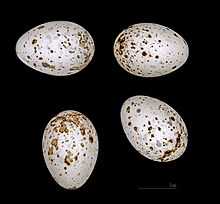Western Orphean warbler
| Western Orphean warbler | |
|---|---|
 | |
| Adult male (center) | |
| Conservation status | |
| Scientific classification | |
| Kingdom: | Animalia |
| Phylum: | Chordata |
| Class: | Aves |
| Order: | Passeriformes |
| Family: | Sylviidae |
| Genus: | Sylvia |
| Species: | S. hortensis |
| Binomial name | |
| Sylvia hortensis (Gmelin, 1789, France) | |
The western Orphean warbler (Sylvia hortensis) is a typical warbler of the genus Sylvia. This species occurs in summer around the Mediterranean, through western Europe and extending into northwest Africa. It is migratory, wintering in sub-Saharan Africa. It is a rare vagrant to northern and north-western Europe.
Taxonomy and systematics
Two subspecies are unequivocally accepted,[2] but they are now usually considered separate species.[3][4]
The western Orphean warbler is probably most closely allied to the Arabian warbler, as well as the brown warbler and Yemen warblers which are sometimes placed in Parisoma. They together with the lesser whitethroat group seem to form a distinct clade of typical warblers. The species therein do not appear much alike at first glance, but they all have prominent white throats, lack rufous wing-patches, and usually having dark sides to the head.[3][4]
Description

At 15–16 cm length - somewhat larger than a blackcap - this is one of the largest species of typical warblers. The adult males have a plain grey back and whitish underparts. The bill is long and pointed and the legs black. The male has a dark grey head, black eye mask, and white throat. The iris is white. Females and immatures have a paler head and buff underparts; their grey back has a brownish tinge. The iris is dark in young birds. The song is a series of warbling liroo-liroo and scolding notes.
Behaviour and ecology
These small passerine birds are found in open deciduous woodland. 4-6 eggs are laid in a nest in a bush or tree. Like most "warblers", Orphean warbler is an insectivore.
Notes
- ↑ BirdLife International (2012). "Sylvia hortensis". IUCN Red List of Threatened Species. Version 2013.2. International Union for Conservation of Nature. Retrieved 26 November 2013.
- ↑ Snow, David W.; Perrins, Christopher M.; Doherty, Paul & Cramp, Stanley (1998). The complete birds of the western Palaearctic on CD-ROM. Oxford University Press. ISBN 0-19-268579-1.
- ↑ 3.0 3.1 Helbig, A. J. (2001). Phylogeny and biogeography of the genus Sylvia, in: Shirihai, Hadoram: Sylvia warblers: 24-29. Princeton University Press, Princeton, N.J. ISBN 0-691-08833-0
- ↑ 4.0 4.1 Jønsson, Knud A. & Fjeldså, Jon (2006). A phylogenetic supertree of oscine passerine birds (Aves: Passeri). Zool. Scripta 35(2): 149–186. doi:10.1111/j.1463-6409.2006.00221.x (HTML abstract).
References
- Attribution
 This article incorporates text from a publication now in the public domain: Ward, Artemas (1911). The Grocer's Encyclopedia.
This article incorporates text from a publication now in the public domain: Ward, Artemas (1911). The Grocer's Encyclopedia.
 This article incorporates text from a publication now in the public domain: Porter, Noah, ed. (1913), Webster's Dictionary, Springfield, Massachusetts: C. & G. Merriam Co.
This article incorporates text from a publication now in the public domain: Porter, Noah, ed. (1913), Webster's Dictionary, Springfield, Massachusetts: C. & G. Merriam Co.
External links
| Wikimedia Commons has media related to Sylvia hortensis. |
- Ageing and sexing (PDF; 2.4 MB) by Javier Blasco-Zumeta & Gerd-Michael Heinze
 Texts on Wikisource:
Texts on Wikisource:
- "Beccafico". New International Encyclopedia. 1905.
- "Beccafico". Encyclopædia Britannica (11th ed.). 1911.
- "Beccafico". Encyclopedia Americana. 1920.
